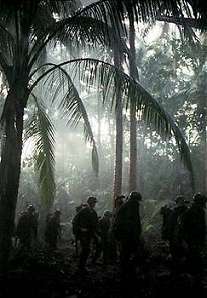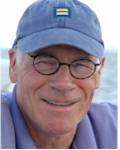Bible | Movies | Books | People | Hot Topics | Holidays | Humor | Gallery | Sanctuary | Sermons | Prayer | Quizzes | Communities | God | FAQ | Links
|
Sponsored Link |
This is one of the best war movies every made. Moreover, director Terrence Malick (The Days of Heaven, 1978) returns to movie making after a long absence with a work that probes poetic and philosophical depths as few movies of any kind have ever done. If you are looking for a film that reaches far beyong the familiar questions concerning the terror and evil of warfare, this is it. And in this sense it makes Saving Private Ryan seem conventional and shallow by comparison. Not to say that Malick's creation is without its flaws. In fact, its length (nearly three hours) and lack of clear plot lines alone will leave many viewers cold. Malick defies the odds by taking his time, and allowing the film to unfold with a deliberate pace that forces the viewer to savor both its stunning scenery and its narrators' innermost thoughts and feelings. And in doing so, he leads his audience on a journey of discovery that explores some of the same terrain covered by biblical works such as the book of Job and the Psalms. Early on the soldier/sage, Pvt. Witt, played convincingly by Jim Caviezel asks, "What is this war at the heart of nature?" When the question arises the Private is wandering AOL through the forests and beaches inhabited by the peaceful Melanesians of the Solomon Islands. Soon that peace will be shattered by the explosive violence of the World War II battle of Guadalcanal. No, the battle scenes here do not reach the intensity or the graphic power of the opening sequences in Saving Private Ryan.The real focus here is not in the detail of dates or places, nor even in the overarching questions that arise when the characters in this film are confronted with the absurdity of war. Rather, in asking that opening question, Malick is drawing our attention to the violence that is an instrinsic part of life itself, a violence that continues long after the guns of battle are silenced. The contest between the Japanese and the Americans, the conflict that divides one soldier in C-for-Charlie Company against another, the clash of feelings that occurs within the mind of a single soldier, all of these play out in counterpoint to the incredible beauty of the natural world. As the soldiers make their way through a forest whose canopied trees, birds and flowers resemble the colorful, hallowed space of a Gothic cathedral, the film-maker reminds us that there is a mystery at the very heart of life that is itself divine. Is God then to be found in the heart of darkness, as well as in the light of day? And if so, is that same God ultimately as responsible for the violence as for the good things which we more readily accept as gifts from heaven? Malick has the courage to answer both those questions in the affirmative, and the skill to lead us toward the point of seeing exactly what he means. Malick has attempted to make a war movie drive toward a point of mystical illumination. Depending upon what the viewer is prepared to see, he either succeeds or fails. I, for one, believe he succeeds.
Please take a moment to let us know you
were here!
If you want to talk with someone in person, please feel free to call 917-439-2305
The Rev. Charles P. Henderson is a Presbyterian minister and is the author of God and Science (John Knox Press, 1986). Charles also tracks the boundry between the virtual and the real at his blog: Next World Design, focusing on the mediation of art, science and spirituality in the metaverse. For more information about Charles Henderson. |
Sponsored Link
|
|||||


